If you live in Connecticut, you are probably familiar with the sound of staccato pecking in the spring. That’s when woodpeckers are busy making nests and breeding in the state. There are seven species of woodpeckers in Connecticut, and nearly all of them live in the area all year-round.
Connecticut offers a few excellent places to find these unusual birds. You can spot them in cemeteries, parks, woodlands, suburban yards, and even in cities if you look high up at the tops of telephone poles.
Whether you are an avid birdwatcher or just have a soft spot for woodpeckers, this guide shares all you should know about Connecticut’s wonderful woodpeckers.
Here is the list of species of woodpeckers in Connecticut:
- Pileated Woodpecker
- Downy Woodpecker
- Northern Flicker
- Hairy Woodpecker
- Red-Headed Woodpecker
- Yellow-Bellied Sapsucker
- Red-Bellied Sapsucker
7 Types of Woodpeckers in Connecticut
1. Pileated Woodpecker
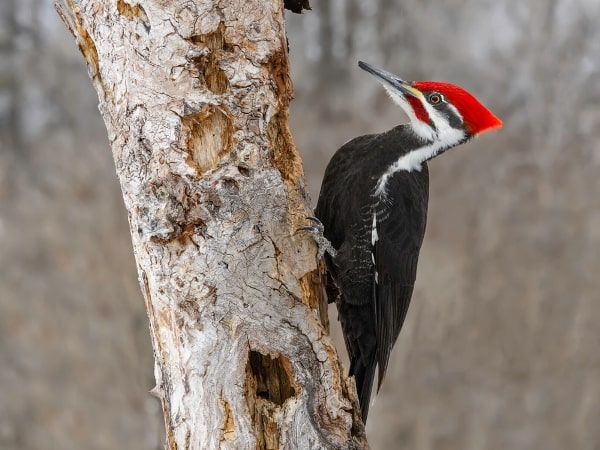
Scientific name: Dryocopus pileatus
Size: 16-19 inches
Weight: 9-14 ounces
Wingspan: 30 inches
The pileated woodpecker lives in Connecticut year-round, and they prefer forests with lots of tall trees. They often make their nests in utility poles or high up in the deadwood of tall trees. Their favorite meal is carpenter ants, which they will dig rectangular holes deep into the wood to find.
They’ll also eat nuts and berries and will even dine on poison ivy berries. You may occasionally see them foraging on the ground for food, but they usually stick to the trees.
These distinctive birds are mostly black and white, but they stand out because of their bright red crest. The males also have a red stripe on the side of their faces. These are large birds, about the same size as a crow, and are the largest woodpeckers in Connecticut.
The pileated woodpecker doesn’t migrate. It stays in the same area for its entire life. They will, however, move their nest to someplace nearby if the eggs fall out of it.
The cartoon bird Woody Woodpecker was probably based on this species. It’s pretty easy to see the resemblance if you compare the comic bird to these woodpeckers.
2. Downy Woodpecker
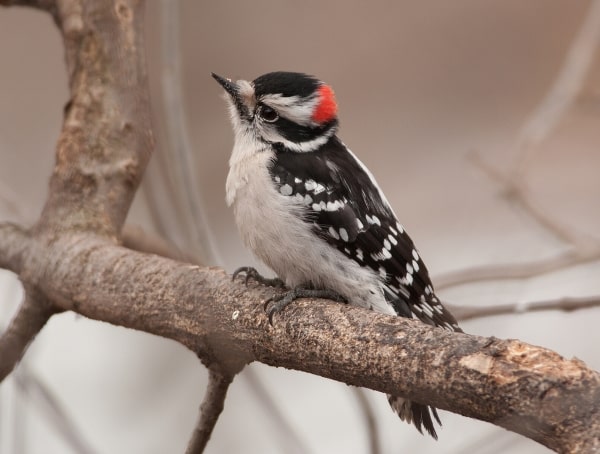
Scientific name: Dryobates pubescens
Size: 7 inches long
Weight: 0.75-0.99 ounces
Wingspan: 10-12 inches
The downy woodpecker is the smallest woodpecker in Connecticut, but its tiny size doesn’t make it difficult to spot. That’s because it’s pretty bold and isn’t afraid of people. It’s probably the most common woodpecker to see in all of Connecticut, so the chances are good that you’ll be able to add this petite woodpecker to your Life List.
Another reason that they’re so easy to spot is that this cute little bird doesn’t migrate. Instead, they stay in their home year-round, which means you can find these woodpeckers even during the winters in Connecticut when some other birds head south.
The downy woodpecker lives everywhere in Connecticut, including in rural areas, cities, suburban yards, and wilderness areas.
During the wintertime, they flock with other birds such as chickadees and nuthatches for safety and to find food. They build their nests in the cavity of trees where they live and raise their young. While they may change their habitat range during the seasons, they don’t travel too far.
Downy woodpeckers are black and white, with distinctly spotted wings and a white chest. Adult males have a bright red cap on the back of their heads, which makes them easy to identify from females.
Hang a suet feeder in your yard to attract downies. They’re the most frequent visitor of suet feeders of all the different woodpeckers in Connecticut.
Because of their small size, they can land on small stems of plants to hunt for food. They’re also small enough that they often make nests in the wood siding of homes, much to the dismay of homeowners.
3. Northern Flicker
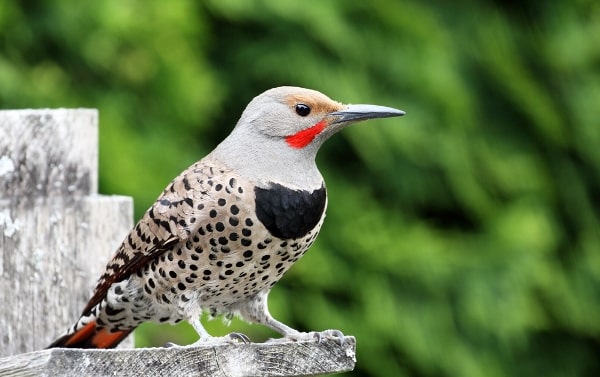
Scientific name: Colaptes auratus
Size: 11-12 inches
Weight: 4-6.5 ounces
Wingspan: 16.5-20 inches
The distinctive northern flicker woodpecker lives in open habitats near trees, as well as in parks and cemeteries across Connecticut. They are a frequent visitor to suet feeders in suburban and urban yards. Unlike some woodpeckers, they like to hunt around on the ground rather than in the trees.
These are the second largest woodpeckers in Connecticut, and they’re another one of the most common types of woodpeckers in Connecticut. They’re quite distinct looking, so they aren’t difficult to identify.
The males, females, and juveniles vary in appearance depending on where they live. They’re brown in color overall, with black spots. The underside of the wings and tails are yellow in the eastern half of the US and red in the western half of the US.
Some have a red or black stripe on their cheeks, and many of them have large, black crescents on their chest. Others have red marks on the back of the head. Some have a slightly gray head.
In the spring, you can hear the calls of Northern flickers for a long way off. They have an extremely distinct call, and once you know what it sounds like, it’s easy to tell when they’re nearby.
They primarily eat ants, but they’ll also dine on other insects such as caterpillars, beetles, and termites. This is definitely a bird you want to have around! There are also instances of them catching young bats as they leave the nest. You can tempt them to visit your home by offering a suet feeder in the yard.
Flickers who live in northern climates like Alaska and Canada will migrate to places with warmer temperatures during the winter, but these woodpeckers stick around Connecticut all year round.
Studies show that Northern Flickers can lose their nests to invaders like European starlings.
4. Hairy Woodpecker

Scientific name: Picoides villosus
Size: 7.5 inches
Weight: 1.4-3.4 ounces
Wingspan: 13-16 inches
Hairy woodpeckers look similar to downy woodpeckers, but they’re easy to tell apart because Hairy woodpeckers are larger. They also have longer bills, which are almost the same length as their head.
They’re black and white. You can tell the genders from one another because the adult males have a little red spot on the back of their heads.
These pretty woodpeckers aren’t as common in Connecticut as their cousin, the downy woodpecker. However, you can still see them in parks, suburban areas, cemeteries, and other quiet wooded or open areas. They also visit suet feeders.
Hairy woodpeckers don’t migrate during the cold weather and stay in the same place all year. They make their homes in the cavities of dead trees.
Research published in The Journal of Wildlife Management found that they prefer forests that have been recently burned because there is abundant food for them there.
Populations have been declining in the past few decades because they’re losing their habitat. They also face pressure from invasive birds like European starlings, which steal their nesting spots.
5. Red-headed Woodpecker
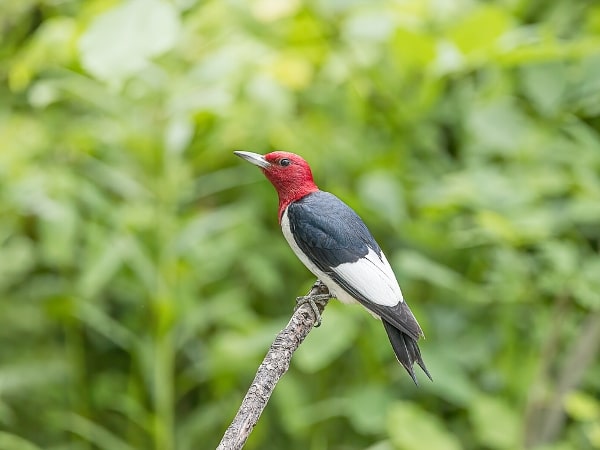
Scientific name: Melanerpes erythrocephalus
Size: 7.5-9.1 inches
Weight: 2.0-3.2 ounces
Wingspan: 16.5 inches
Red-headed woodpeckers are pretty birds. They have solid black wings with a big white patch and white bodies. To top it off, they have a deep, dark red head and neck that is so vibrant it looks like velvet.
The juveniles are brownish-black with white spots on the wings and dull red cheeks.
They don’t cross to the west side of the Rocky Mountains, but they can be found in all parts east, from Canada to Florida. These woodpeckers live in Connecticut year-round, but only since the 1950s. You might be able to entice them to your yard by offering them some citrus or suet.
It’s one of the few woodpeckers out there who like to store food for the winter. They stuff seeds and nuts in bark or holes in trees. They have even been known to stuff food under shingles.
They also hunt their prey, snatching insects out of the air as they fly. That’s uncommon behavior for woodpeckers.
6. Yellow-bellied Sapsucker
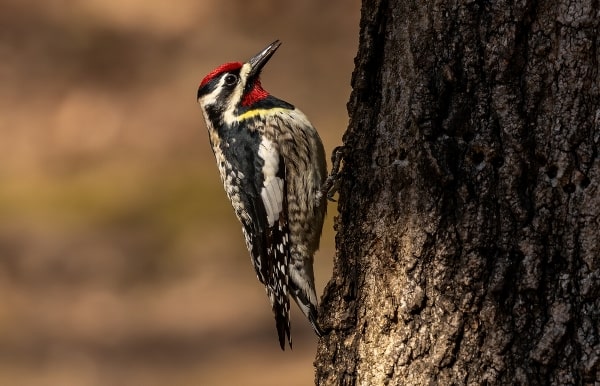
Scientific name: Sphyrapicus varius
Size: 7.1-8.7 inches
Weight: 1.5-1.9 ounces
Wingspan: 13.4-15.8 inches
The yellow-bellied sapsucker breeds in northern Connecticut and hangs out in the south part of the state during the nonbreeding season.
These birds are primarily black and white, with white bellies and black and white barred wings and back. You can tell the difference between males and females because the male’s throat is bright red. Females, on the other hand, have a white throat. Both the females and males have red foreheads.
The females have a faint yellow coloring on bellies, but it can be so indistinct that you might not be able to identify it unless you get close.
These sapsuckers drill tiny holes with their beaks, and then they wait for the sweet sap to leak from the tree. They lick this up, along with any insects that crawl along and get stuck in the sap.
You might see them hanging out at your backyard suet feeder, but they mostly stick to forested areas. They aren’t nearly as bold as some of their woodpecker cousins.
7. Red-bellied Woodpecker
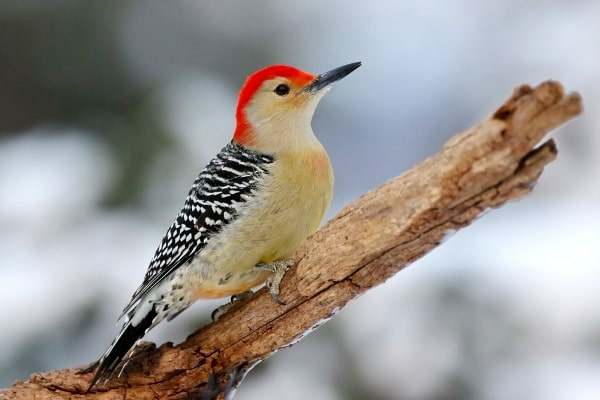
Scientific name: Melanerpes carolinus
Size: 9.5 inches
Weight: 2.0-3.2 ounces
Wingspan: 13.0-16.5 inches
You’d probably expect these woodpeckers to have bright red bellies given their name, but that’s not the case. Their bellies are typically pale, creamy white. Their back and wing feathers are black and white striped, and the females have a red nape. The males have a red nape and crown.
So, where did the name “red-bellied” come from? The woodpeckers actually have red feathers on their bellies, but they’re covered by white feathers, so you can’t see them very well.
These active woodpeckers live all across the eastern United States, including Connecticut, New York, New Jersey. You can identify them in the air as they fly by their undulating flight pattern.
Look for them in oak and hickory trees, where they like to feed and nest. They’ll also visit suet feeders in gardens and yards.
Also Read: Owls in Connecticut
